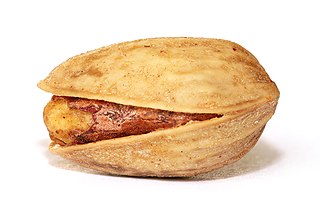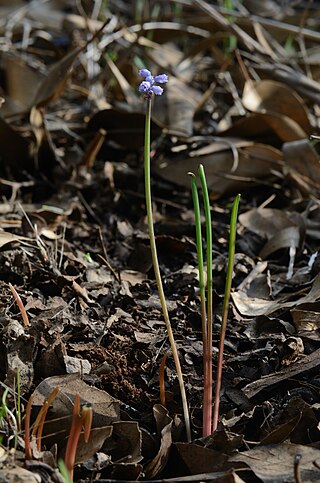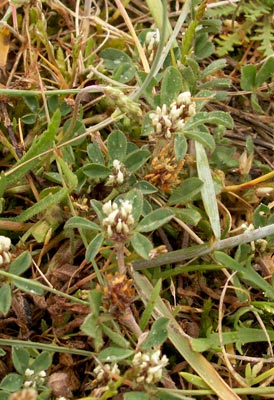
The pistachio, a member of the cashew family, is a small tree originating from an area that includes Afghanistan, Central Asia, and Iran. The tree produces seeds that are widely consumed as food.

Pistacia is a genus of flowering plants in the cashew family, Anacardiaceae. It contains 10 to 20 species that are native to Africa and Eurasia from the Canary Islands, all of Africa, and southern Europe, warm and semidesert areas across Asia, and North America from Mexico to warm and semidesert United States, such as Texas or California.

Pistacia terebinthus also called the terebinth and the turpentine tree, is a deciduous tree species of the genus Pistacia, native to the Mediterranean region from the western regions of Morocco and Portugal to Greece and western and southeastern Turkey. At one time terebinths growing on the eastern shores of the Mediterranean Sea were regarded as a separate species, Pistacia palaestina, but these are now considered to be a synonym of P. terebinthus.

Pistacia atlantica is a species of pistachio tree known by the English common name Mt. Atlas mastic tree, Atlas pistachio, Atlantic pistacio, Atlantic terebinth, Cyprus turpentine tree, and Persian turpentine tree.

Pistacia khinjuk is a species of plant in the family Anacardiaceae native to Egypt, western Asia and parts of the Himalayas. The tree grows up to 10 metres. The epithet comes from the name for the plant in Balochistan, khinjuk (خنجک).

Centaurium tenuiflorum, the slender centaury, is a species of annual herb in the family Gentianaceae. They have a self-supporting growth form and simple, broad leaves. Individuals can grow to 17 cm tall.
Crepis pusilla is a species of plants in the family Asteraceae.
Eleocharis ovata, the ovate spikerush, is a species of annual grass in the family Cyperaceae (sedges). They have a self-supporting growth form and have simple, broad leaves and green flowers. Individuals can grow to 1.5 feet.

Euphorbia terracina, the Geraldton carnation weed, is a species of perennial herb in the family Euphorbiaceae. It has a self-supporting growth form and simple, broad leaves. Flowers are visited by Lipotriches brachysoma, Lipotriches natalensis, Lipotriches crassula, and Nomia bouyssoui.
Hypericum australe is a species of plant in the family Hypericaceae. Individuals can grow to 24 cm tall.
Lycium ferocissimum, the African boxthorn, is a species of shrub in the family Solanaceae (nightshades). They have a self-supporting growth form. Individuals can grow to 1.5 m.

Lycium intricatum, the southern boxthorn, is a species of plants in the family Solanaceae (nightshades).

Muscari parviflorum is a species of plants in the family Asparagaceae.

Vulpia fasciculata, the dune fescue, is a species of annual herb in the family Poaceae. They have a self-supporting growth form and simple, broad leaves. Individuals can grow to 0.24 m.

Scorzonera laciniata, also known as cutleaf vipergrass, is a species of herb in the family Asteraceae.

Polypogon viridis, the beardless rabbitsfoot grass, is a species of perennial grass in the family Poaceae. They have a self-supporting growth form and simple, broad leaves. Individuals can grow to 0.43 m.

Tamarix africana, the African tamarisk, is a species of tree in the family Tamaricaceae. They have a self-supporting growth form and simple leaves. Individuals can grow to 6.3 m.

Trifolium lappaceum, the burdock clover, is a species of annual herb in the family Fabaceae. They have a self-supporting growth form and compound, broad leaves.

Trifolium scabrum, the rough clover, is a species of annual herb in the family Fabaceae. They have a self-supporting growth form and compound, broad leaves. Individuals can grow to 0.12 m.

Trifolium suffocatum, the suffocated clover, is a species of annual herb in the family Fabaceae. They have a self-supporting growth form and compound, broad leaves. Individuals can grow to 4.2 cm.
















